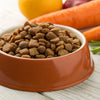What to Give a Dog to Gain Weight: Comprehensive Guide for Pet Owners
- Houndsy
Table of Contents
- Introduction
- Understanding Underweight Dogs
- Nutritional Strategies for Weight Gain
- Exercise and Activity Levels
- Monitoring Progress and Adjustments
- Conclusion
- FAQ
Introduction
Have you ever looked at your dog and felt a pang of concern because their ribs seem too visible, or their coat lacks luster? You're not alone. According to recent statistics, approximately 15% of dogs are considered underweight, which can lead to various health issues, including weakened immune systems and reduced quality of life. As devoted pet owners, it's our responsibility to ensure that our furry friends are not just healthy but thriving.
In this blog post, we will delve into the essential topic of canine weight gain, exploring what to give a dog to gain weight effectively and safely. We aim to equip you with practical knowledge, discussing dietary adjustments, suitable foods, and feeding routines that can help your dog reach their ideal weight. By the end of this article, you will have a well-rounded understanding of how to approach weight gain for your dog, ensuring they remain healthy and happy.
We'll cover various aspects, including the underlying causes of weight loss, the healthiest foods to introduce, and the importance of exercise in conjunction with a nutritious diet. So let’s embark on this journey together and explore how we can help our beloved pets gain the weight they need!
Understanding Underweight Dogs
Signs Your Dog is Underweight
Recognizing an underweight dog is the first step in addressing their nutritional needs. Here are some common signs to look for:
- Prominent Ribs and Spine: If you can easily see or feel your dog’s ribs and spine without applying pressure, it's a clear indication they may be underweight.
- Loss of Muscle Mass: An underweight dog often shows a reduction in muscle around the hips and shoulders.
- Visible Waists: A pronounced waist when viewed from above can signify that your dog is too thin.
- Lethargy or Reduced Energy: If your dog seems less active or playful than usual, it could indicate insufficient caloric intake.
Health Risks of Being Underweight
Maintaining a healthy weight is crucial for your dog’s overall well-being. Underweight dogs are at a higher risk for several health problems, including:
- Weakened Immune System: A lack of essential nutrients can compromise your dog’s immune response.
- Digestive Issues: Insufficient weight can lead to gastrointestinal problems, making it harder for your dog to absorb nutrients.
- Increased Risk of Injury: Low body weight may result in decreased muscle mass, making your dog more prone to injuries.
Causes of Weight Loss
Understanding why your dog is underweight is vital before implementing any dietary changes. Common reasons include:
- Medical Conditions: Diseases such as diabetes, hyperthyroidism, or gastrointestinal disorders can contribute to weight loss.
- Stress and Anxiety: Changes in environment or routine can lead to stress-induced weight loss.
- Poor Diet: Feeding a low-quality diet or not enough food can result in insufficient caloric intake.
If you suspect a medical issue is causing your dog’s weight loss, it’s essential to consult with a veterinarian to rule out any serious conditions.
Nutritional Strategies for Weight Gain
High-Calorie Foods for Dogs
When considering what to give a dog to gain weight, focusing on high-calorie, nutrient-dense foods is crucial. Here are some excellent options:
1. High-Fat Dog Food
Opt for dog food that contains a higher percentage of fat and protein. Look for brands that specifically cater to weight gain. The Houndsy Kibble Dispenser can help ensure your dog gets the right portions without the mess.
2. Wet Food
Wet food is often more palatable and easier for dogs to eat. It can also provide additional moisture, which is beneficial for hydration.
3. Human Foods for Dogs
Certain human foods can be great supplements to your dog's diet. Here are some nutritious options:
- Peanut Butter: High in healthy fats and protein, peanut butter can be a tasty addition to meals or given as a treat. Just ensure it’s xylitol-free.
- Cottage Cheese: This is a great source of protein and is generally well-tolerated by dogs, even those with mild lactose intolerance.
- Pumpkin: Adding pureed pumpkin can help with digestion and provide extra calories.
- Sweet Potatoes: Rich in fiber and carbohydrates, sweet potatoes are a healthy addition that can help with weight gain.
Portion Control and Feeding Frequency
While choosing the right foods is essential, how you feed your dog also plays a significant role in weight gain. Here are some tips:
1. Increase Meal Frequency
Instead of two large meals, consider feeding your dog smaller meals throughout the day. This can help with digestion and increase caloric intake.
2. Gradual Portion Increase
If your dog isn’t gaining weight, gradually increase their food portions by about 10-20% until you see a positive change.
3. Monitor Weight Regularly
Keep track of your dog’s weight every couple of weeks to ensure they are progressing towards their ideal weight. If there’s no improvement, consult your veterinarian for further advice.
Exercise and Activity Levels
The Role of Exercise in Weight Gain
While it might seem counterintuitive, exercise is essential for healthy weight gain in dogs. Regular activity helps convert extra calories into muscle rather than fat. Here’s how to approach exercise for underweight dogs:
- Incorporate Strength Training: Activities like resistance training can help build muscle mass.
- Daily Walks: Consistent walks not only keep your dog active but also stimulate their appetite.
- Playtime: Engage your dog in fun activities like fetch or agility training to keep them mentally and physically stimulated.
Creating a Balanced Routine
Balancing diet and exercise is key. While you want to increase caloric intake, ensuring that your dog remains active will help maintain a healthy weight and prevent obesity.
Monitoring Progress and Adjustments
Keeping a Feeding Diary
Maintaining a diary of what your dog eats and their exercise routine can help you identify patterns and make necessary adjustments. Note their weight regularly and any changes in appetite or energy levels.
Consulting Your Vet
If you’re unsure about your dog’s diet or weight management plan, consulting your veterinarian is always a good idea. They can provide tailored advice based on your dog’s specific needs and health history.
Conclusion
Helping your dog gain weight is a multifaceted approach that includes selecting the right foods, adjusting feeding routines, and ensuring they stay active. By understanding the causes of underweight issues and implementing these strategies, we can help our furry companions achieve a healthy weight and enjoy a vibrant, happy life.
As we embark on this journey of nurturing our pets, let’s not forget the importance of making feeding convenient. Products like the Houndsy Kibble Dispenser can simplify portion control, allowing us to focus more on the love and care we provide to our dogs.
If you're ready to elevate your dog feeding experience while helping your pup gain weight, consider exploring the Houndsy Kibble Dispenser for an innovative and stylish solution.
Explore the Houndsy Kibble Dispenser here!
FAQ
1. What should I do if my dog is not gaining weight? If your dog isn't gaining weight despite dietary adjustments, consult your veterinarian to rule out any underlying health issues.
2. Can I feed my dog human food to help them gain weight? Yes, certain human foods like peanut butter, cottage cheese, and sweet potatoes can be beneficial. Always avoid toxic foods like chocolate, grapes, and onions.
3. How often should I feed my dog to help them gain weight? Feeding smaller, more frequent meals can be more effective than two larger meals. Aim for three to four meals a day.
4. Is exercise necessary for underweight dogs? Yes, regular exercise helps convert calories into muscle and promotes overall health.
5. How do I know if my dog is gaining weight? Monitor your dog’s weight weekly and look for changes in their body condition, such as a less prominent ribcage and increased muscle mass.
By taking these steps, we can ensure a healthy, happy future for our canine companions. Remember, a well-fed dog is a happy dog!












